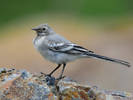search
classification
|
basic information
|
video
|
Masked Wagtail
Motacilla personata (Gould, 1861)

|
 adult
|
|
|
2018-03-10
Bishkek, Chui region |
© Katerina Vorobieva
|
|
Description
The adult Masked Wagtails are very resemble the White Wagtail with which formerly the Masked Wagtail treated as conspecific. It is well distinguished from the White Wagtail by the black flanks of the neck; black extends to the fore part of the mantle. On side view the black color of the head and of the craw is not divided by the white. The median and greater wing coverts are white. The tail is black; outer tail feathers are white. The bill and legs are black. In fresh plumage except the listed features it is also characterised by the throat not white but black with clearly appearing white. The chin is white. Juveniles differ from the White Wagtail by the smoke-grey throat and craw. Weight 21-29 grams, wing 82-99, tail 80-101 mm.
Biology
The Masked Wagtail is common, in places rare, breeding migrant. Inhabits open areas near water with nearby precipices, rocks or constructions in deserts, semi-deserts and mountains up to 2500-3300 m in Tien Shan and 1700-1800 m on Altai. During migration rarely occurs up to 3800 m. Appears late February to early March in southern areas and late March to early April in northern ones and in mountains, by small flocks of 10-20 birds; last spring migrants recorded late April to mid May. Breeds in separate pairs at 30-200 m one from another. Nest is built in precipices, in rocks, between stones, in walls, in cavities of constructions, under the bridges and in disused machinery. Rare nests in tree, on 2-3 m high in poplar, willow or spruce. Both partners build nest from the dry grass, twigs and rootlets; and line it with plenty of hair, some cotton and feathers, for 3-23 days. Artificial objects (cigarette ends, paper, wire) are also used. Clutches of 3-7 eggs appear end April to mid July. Only female incubates for 11-13 days. Both parents feed juveniles, which fledge at age 14-17 days, at end May – early August. Double brooded, repeated breeding after first nest losing is common. It eats only insects and its larvas. In large number it kills the gnats hunting them on flight. Autumn movement begins in mid August in highlands and continues till mid September – early October. In foothills most birds migrate in September, last recorded in late October.
References
Gavrilov E. I., Gavrilov A. E. "The Birds of Kazakhstan". Almaty, 2005. "Птицы Казахстана" том 3. "Наука". Алма-Ата, 1970. Э.И.Гаврилов. "Фауна и распространение птиц Казахстана". Алматы, 1999. А.Ф.Ковшарь "Певчие птицы". Алма-Ата, "Кайнар", 1983.








